Today the weather doesn't show an improvement over yesterday. It rains and a stiff breeze is blowing. Instead of revisiting Salisbury Plains the plan is to visit Albatross Island during the morning. Visits to this island are strictly regulated and the staff has to flag a route before we're allowed land.
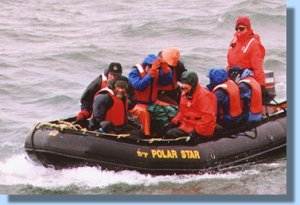
When the first zodiac leaves the Polar Star, the wind blows at 25 knots. By the time the route has been marked and we're allowed to go ashore, it has increased to 35 knots. Gusts of wind fill the air with a salty spray and the waves all have white crests. By 10.30 AM we're in the middle of a storm and Doug decides to cancel the landing. The two zodiacs that are still out have quite some problems with the waves but finally manage to come aboard safely.
As the weather probably won't improve soon we decide to go to a typical rainy afternoon place: a museum. So the anchor is raised and we're heading for Grytviken. This will take us about three hours of sailing. By the time we arrive in Grytviken, the wind has abated and it's raining steadily. Through the curtains of rain we have a good view on the dilapidated buildings of the old Norwegian whaling station of Grytviken.
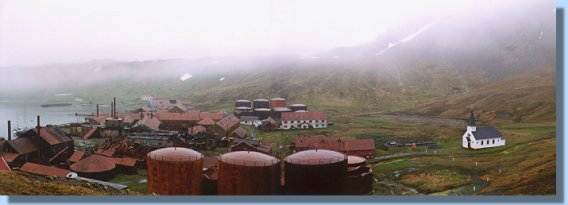 In 1904 Grytviken was chosen by the Norwegian Captain Carl
Anton Larsen as the site of the first whaling station in Antarctic waters. In
the first year of its operation 183 whales were taken. Unfortunately the number
of whales taken quickly increased. At the height of the whaling industry about
300 people were working in Grytviken every season from October to March. Thousands
of whales were being processed. In 1965 when Grytviken closed as last of the
six South Georgian whaling stations more than 175,000 whales were taken bringing
the whale population on the brink of extinction.
In 1904 Grytviken was chosen by the Norwegian Captain Carl
Anton Larsen as the site of the first whaling station in Antarctic waters. In
the first year of its operation 183 whales were taken. Unfortunately the number
of whales taken quickly increased. At the height of the whaling industry about
300 people were working in Grytviken every season from October to March. Thousands
of whales were being processed. In 1965 when Grytviken closed as last of the
six South Georgian whaling stations more than 175,000 whales were taken bringing
the whale population on the brink of extinction.
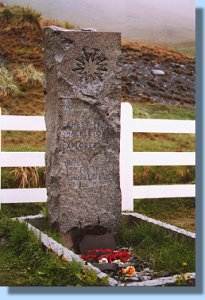
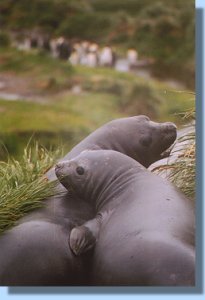
A zodiac brings us ashore and after a short walk between fur seals, elephant seals and a small group of moulting king penguins we reach a small whaler's cemetery. 63 People are buried here, mostly Norwegian whalers. But it also hosts the grave of the famous British polar explorer Sir Ernest Shackleton who died here of a heart attack on January 5, 1922 aboard his ship Quest. Shackleton's grave is easily distinguished by a 2 meter high granite stone engraved with the nine-pointed star he used as a personal symbol.
Shackleton, or "the boss" as his men called him became a legend for his epic "Endurance"-expedition. Aiming at the first crossing of the white continent, his ship was caught in the ice and finally crushed. Living on the pack ice for five months they managed to reach Elephant Island. From there Shackleton sailed in a small boat, the "James Caird" 1300 km out in the open sea to South Georgia. After 16 exhausting days they landed on South Georgia. Being on the "wrong" side Shackleton crossed the 1800 meter high glacier covered mountain range before he was able to reach the inhabited world. At the end, almost two years after their departure all his men were saved.
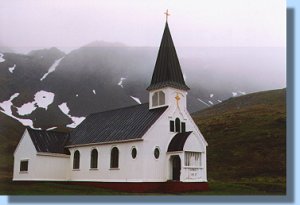
From the cemetery we walk towards Grytviken. Unfortunately walking between the old buildings is not allowed anymore. Instead we have to walk around it. Via a muddy path and over the former whaler's soccer field we reach the recently restorated whaler's church. Inside there are memorials to Carl Anton Larsen and Sir Ernest Shackleton. The whaler's church is the only building in Grytviken that retains its original function. A box with candles show that services are still being held here every now and then.
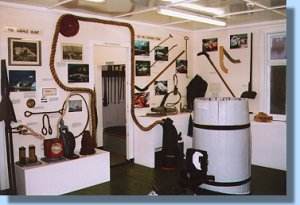
With time ticking away we have to hurry to visit the museum. Housed in the former Manager's Villa, it has very interesting displays on Shackleton's epic journey South, Grytviken's whaling past and South Georgia's flora and fauna. Tim and Pauline Carr who came to South Georgia on their yacht 10 years ago and haven't left since run the museum. After posting a few postcards (next collection: in 8 days) and buying some souvenirs, the last zodiac shuttles us back to the Polar Star. It has been raining all day long.
Tim, Pauline and the other permanent inhabitants join us for dinner. After dinner Tim and Pauline present us their slideshow on South Georgia. Beautiful pictures proof us that the weather can be fine on South Georgia. But not today! When our guests return to shore around midnight the steady rain has changed into a real downpour. Fortunately we don't have to go out with them.